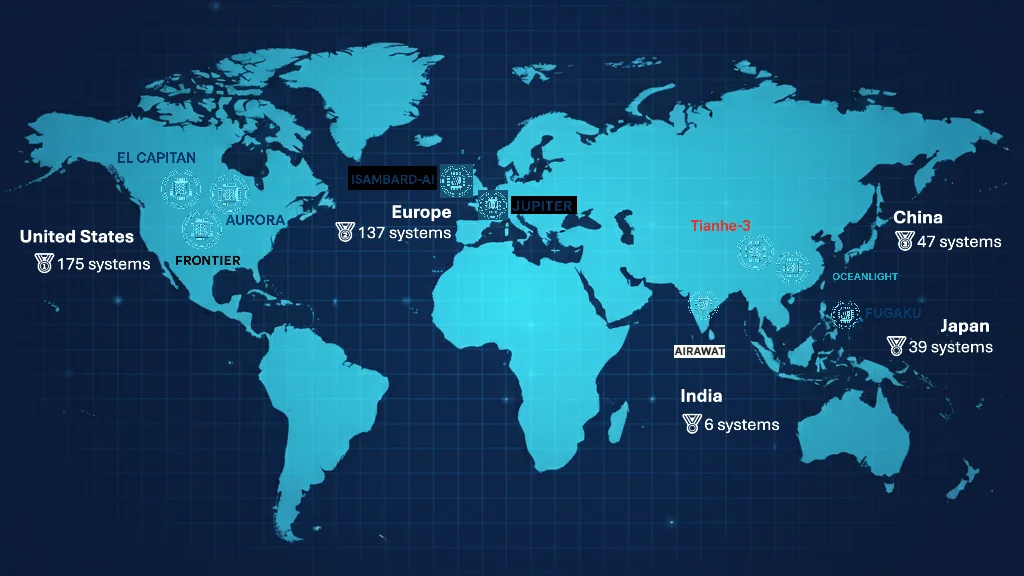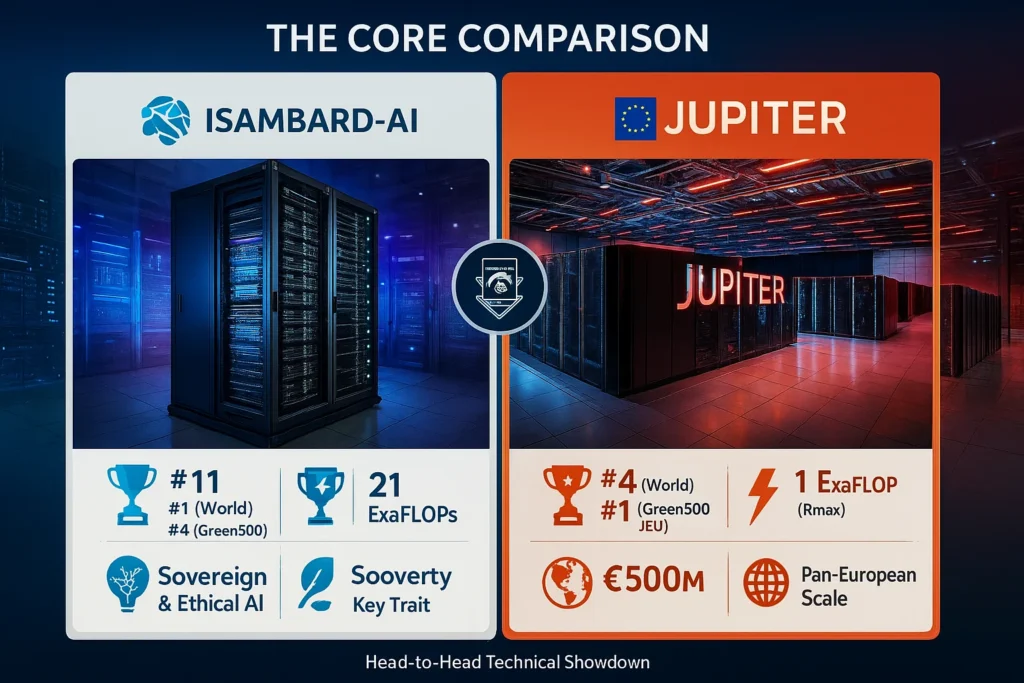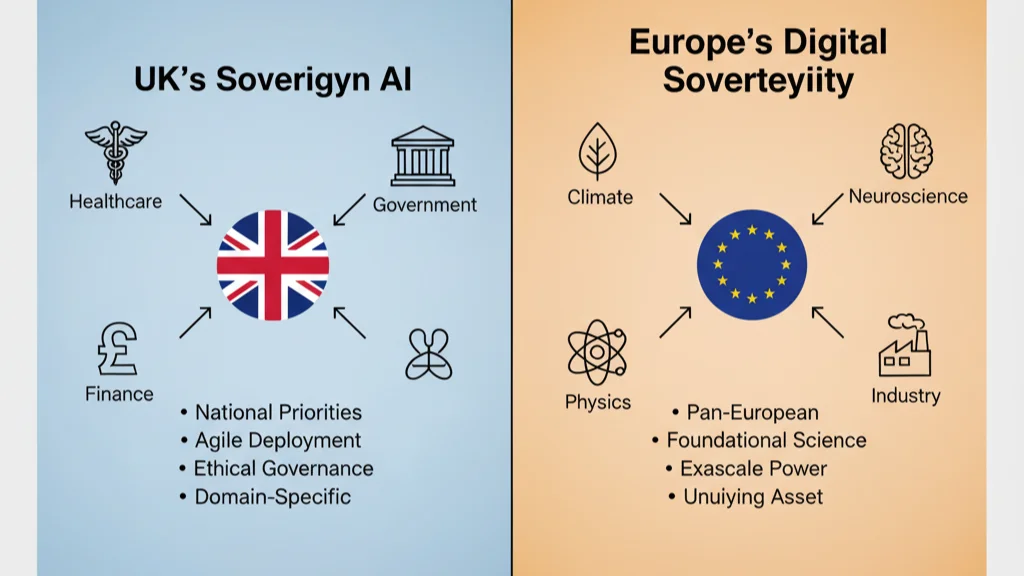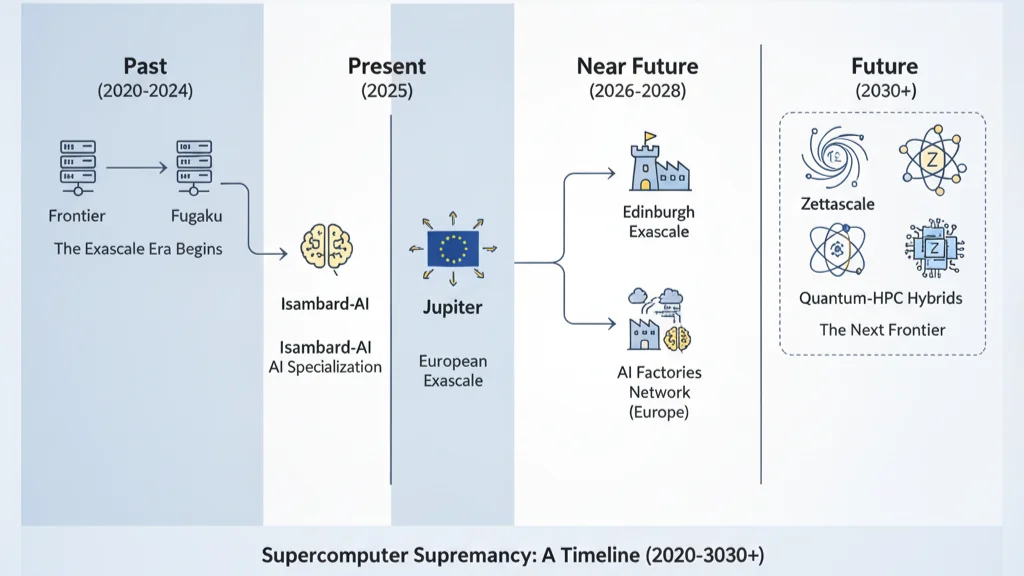Isambard-AI vs Jupiter: The Battle for Supercomputer Supremacy (2025)
UK’s Agile AI Powerhouse vs. Europe’s Exascale Leviathan: A Strategic Deep Dive into the Future of Compute
Isambard-AI vs Jupiter: We compare the UK’s AI powerhouse (21 exaflops, ethical focus) with Europe’s exascale giant. Who wins on performance, energy efficiency & scientific impact? Explore the 2025 showdown.
Table of Contents
The global race for artificial intelligence (AI) supremacy is no longer fought just in algorithms, but in monumental feats of engineering. In 2025, two new titans entered the arena, each embodying a distinct vision for the future: the United Kingdom’s Isambard-AI and the European Union’s JUPITER. This isn’t just a clash of processing power; it’s a fundamental debate between targeted, sovereign AI and raw, continental-scale compute. We cut through the specs to deliver the definitive verdict on who wins this high-stakes battle and what it means for the future of technology. This clash of compute power is a key driver of the broader AI revolution, which is fundamentally transforming how research is conducted and knowledge is created.
Historical & Strategic Context: The Road to Exascale
Before diving into the head-to-head comparison, it’s essential to understand the competitive arena. The launch of JUPITER and Isambard-AI is part of a global race where nations treat computational power as a strategic national asset — a kind of “space race for the digital age.”
The United States currently leads in scale, hosting the fastest supercomputers on the TOP500 list (as of June 2025). China, though often secretive about its true capacity, maintains a formidable presence. Japan and India have also entered the exascale club with their own high-performance systems.

Within this fierce competition, Europe’s JUPITER is a direct and symbolic response. As the first European exascale machine and a top-five global system, it represents not only a scientific breakthrough but also a statement of technological sovereignty.
The UK’s approach with Isambard-AI is more specialized but no less strategic. Instead of competing solely on raw metrics, the UK is carving out leadership in sovereign and ethical AI, emphasizing real-world applications, public good, and national interests. This reflects a broader global debate: should AI supremacy be defined by raw compute, or by strategically applied influence and governance?
In this context, the JUPITER vs. Isambard-AI comparison is more than technical — it embodies two different visions of how nations can wield computational power in the era of exascale and artificial intelligence.
The Core Comparison: Isambard-AI vs Jupiter on Technical Specifications
A direct comparison of Isambard-AI and JUPITER reveals a tale of scale versus specificity. The following data, sourced from the June 2025 TOP500 and Green500 lists, highlights their divergent architectures.

| Feature | Isambard-AI | JUPITER |
|---|---|---|
| Global Rank (TOP500) | 11 | 4 |
| European Rank (TOP500) | 6 | 1 |
| Global Rank (Green500) | 4 | 1 (JEDI Prototype) |
| Rmax (Petaflop/s) | 216.50 | 793.40 |
| Rpeak (Petaflop/s) | 278.58 | 930.00 |
| Power Consumption | Not Listed | ~13,088 kW |
| Core Technology | NVIDIA Grace Hopper Superchip | NVIDIA Grace Hopper Superchip |
| Key Achievement | 21 AI ExaFLOPs, rapid deployment | First EU Exascale Supercomputer |
Raw Computational Power: Exascale vs. AI-Focused Exaflops
In the realm of raw computational power, JUPITER claims a decisive victory. As Europe’s first exascale supercomputer, it performs a staggering 793.4 Petaflop/s (nearly 0.8 Exaflop/s), ranking it 4th globally and making it an undeniable force for continent-wide research. Its scale is designed to tackle simulations of unprecedented complexity.
Isambard-AI, while ranked 11th globally with an Rmax of 216.5 Petaflop/s, was never designed to win this raw power race. Its triumph is different: it delivers a massive 21 exaflops of AI performance according to its architects at NVIDIA. This specialized power is tailored for training and running large language models (LLMs) and AI applications, making it a sovereign tool for the UK’s national AI strategy.
Energy Efficiency: A Shared Commitment to Green Computing
Both systems are leaders in sustainability, a critical metric for modern supercomputers. JUPITER’s prototype, the JEDI system, currently holds the #1 spot on the Green500 list, while Isambard-AI is ranked an impressive #4 globally. Both achieve this through advanced engineering: JUPITER uses a warm-water cooling system to heat local buildings, while Isambard-AI employs a zero-carbon electricity supply and HPE’s 100% fan-less direct liquid cooling technology.
Architectural Divergence: Modular Agility vs. Monolithic Might
The technical specifications in our comparison are not arbitrary; they are the direct result of fundamentally different architectural philosophies. These design choices reveal the core strategic priorities of each project: one values rapid, flexible deployment, while the other pursues ultimate, stable scale.
Isambard-AI’s “Lego Block” Agility
Isambard-AI was constructed with a focus on speed and adaptability. Its secret weapon is its use of modular data center technology, specifically HPE’s Performance Optimized Datacenter (POD). Think of it as building with high-tech Lego blocks—pre-fabricated units that can be rapidly assembled on-site.
This approach allowed the system to go from contract to full operation in under two years, an incredibly short timeframe for a machine of this class. This “time-to-science” is a critical metric. For the UK’s strategy, being able to quickly provide researchers with a sovereign AI tool is a strategic advantage in the fast-moving AI landscape, where a delay of a year can mean missing a crucial technological wave. This modularity also offers potential for easier future upgrades and a smaller initial physical footprint.
JUPITER’s “Integrated Titan” Power
In contrast, JUPITER embodies a “monolithic” or fully integrated design. It is a bespoke system, engineered from the ground up within a traditional, custom-built data center hall at the Forschungszentrum Jülich campus. This approach prioritizes maximum, uninterrupted throughput and absolute stability for the massive, long-running simulations it is destined to host.
While this method typically involves a longer planning and construction phase, the result is a system optimized for raw, reliable power. JUPITER is built to be the bedrock of European scientific computing for years to come—a foundational monument of compute power designed for problems that run for months at a time, such as climate modeling or fundamental physics simulations.
The Strategic Trade-Off: Speed vs. Ultimate Scale
This architectural divergence highlights the central of the Isambard-AI vs Jupiter match:
- Isambard-AI chose agility. Its modular design is a strategic bet on getting a powerful, AI-optimized tool into researchers’ hands as quickly as possible, accepting that it may not top the pure exascale charts.
- JUPITER chose scale. Its integrated design is a commitment to achieving maximum, stable performance for the broadest possible range of pan-European scientific workloads, accepting a more traditional and potentially longer deployment path.
This fundamental difference in engineering philosophy is just as important as the raw flop counts. It proves that in the modern supercomputing race, how you build a system can be as strategically significant as how powerful it is.
Use Cases & Research Impact: Theory vs. Tangible Results
The true measure of a supercomputer’s success is not its position on a ranking list, but its ability to solve real-world problems and push the boundaries of human knowledge. Here, the strategic differences between Isambard-AI and JUPITER become most apparent, moving from theoretical power to practical impact.
JUPITER: Enabling Foundational Science on a Continental Scale
As a pan-European resource, JUPITER’s applications are designed to advance foundational science that is too large for any single nation to tackle. Its exascale power enables research that was previously impossible.
- Climate Modeling at Kilometer-Scale Resolution: Partnering with the European Centre for Medium-Range Weather Forecasts (ECMWF), JUPITER will run climate models with unprecedented, kilometer-scale resolution. This will dramatically improve the prediction of extreme weather events like heatwaves and floods, providing crucial data for climate policy and adaptation strategies across the continent.
- Simulating Biological Systems for Drug Discovery: Researchers will use JUPITER to simulate complex biological systems, such as protein interactions or entire cellular processes, with a level of detail that can accelerate the discovery of new pharmaceuticals and therapies for diseases like cancer and Alzheimer’s.
- Fundamental Physics and Neuroscience: From computing the properties of elementary particles to building a foundational model of the human brain down to the cellular level, JUPITER is tasked with answering some of science’s most profound questions. Its role is to serve as a microscope for the universe and the human body, driving pure scientific discovery.
Isambard-AI: Driving Immediate National Impact with Targeted AI
Isambard-AI’s purpose is more focused: to deliver tangible, high-impact benefits to the UK’s economy and public services. Its applications are already underway, demonstrating a “sovereign AI” strategy in action.
- Revolutionizing NHS Cancer Screening via AI: One of its flagship projects involves developing scalable AI models for prostate cancer detection from MRI scans. This initiative, led by University College London, aims to address critical diagnostic backlogs, standardize early detection, and reduce human error, directly improving national healthcare outcomes.
- Powering the Bilingual UK-LLM for Public Services: A prime example of ethical and inclusive AI, Isambard-AI is being used to train a bilingual English-Welsh large language model. This ensures that public services, from healthcare information to legal support, are accessible in regional languages, preserving cultural heritage and ensuring equitable access to AI technology.
- Accelerating Materials Science for Green Technologies: Researchers are using the supercomputer to search through millions of chemical combinations to discover new, sustainable materials for industrial use. This accelerates the development of greener technologies and supports the UK’s transition to a net-zero economy.
As these applications show, the research impact of Isambard-AI vs Jupiter is a direct reflection of their underlying design philosophies. JUPITER acts as a foundational engine for long-term, continent-wide scientific advancement, while Isambard-AI functions as a precision tool for addressing immediate national priorities. This stark contrast in application perfectly sets the stage for understanding the core philosophies that built them.
Philosophical Approaches: Sovereign AI vs. Digital Sovereignty
The technical differences stem from a deeper philosophical divide in strategic vision.
The UK’s “Sovereign AI” Imperative
Isambard-AI is the cornerstone of the UK’s plan to become an “AI Maker, Not a Taker”. Backed by a £225 million investment, it’s part of the UK government’s broader £1 billion compute strategy to build a domestic AI ecosystem and reduce reliance on foreign tech giants. This push for independence is crucial, as relying on external AI systems can create complex challenges in authenticity and authorship that are only now being understood. This sovereign AI approach ensures that critical AI development aligns with national ethical frameworks and legal traditions.
Establishing these frameworks is essential, especially as the line between human and AI-generated content blurs, creating a paradoxical challenge for detection itself. The development of a bilingual English-Welsh LLM for public services is a prime example, ensuring equitable access and preserving cultural diversity.

Europe’s “Digital Sovereignty” Vision
JUPITER, a joint €500 million investment by the EU and Germany, is the flagbearer for European digital sovereignty. Operated under the EuroHPC Joint Undertaking, it’s designed as a unifying, pan-European asset to pull the continent’s research and industry together, ensuring it can compete with the US and China. Its mission is to provide a foundational resource for the entire continent, anchoring a future network of “AI Gigafactories.”
Economic & Political Stakes: The Billions Behind the FLOPs
Beyond the specs and scientific applications lies the true driver of this competition: high-stakes geopolitics. The investments in Isambard-AI (£225 million) and JUPITER (€500 million) are not merely scientific grants; they are strategic bets on economic dominance and political influence in the AI-driven 21st century. The calculus of return on investment here is measured in more than just petaflops per pound.
The Cost-Benefit Analysis of Sovereignty
The disparity in price tags reflects their different scales, but both investments target a common goal: strategic autonomy.
- JUPITER’s €500 Million Gambit: For Europe, this is the cost of entry into the exclusive exascale club dominated by the US and China. The ROI is continent-wide: preventing a “brain drain” of top talent to other regions, creating a magnet for international AI startups that need vast compute, and ensuring that foundational research for future industries (like fusion energy or personalized medicine) happens on European soil, under European regulations.
- Isambard-AI’s £225 Million Strategic Pivot: The UK’s investment is a more focused wager. The return is calculated in sovereign capability. By building a domestic AI infrastructure, the UK aims to avoid the long-term economic and strategic cost of reliance on foreign tech giants. The goal is to foster a self-sustaining ecosystem where British AI innovations—from healthcare diagnostics to legal tech—are developed on British supercomputers, keeping the intellectual property and economic benefits within the national economy.
The Geopolitical Chessboard: Sovereignty, Standards, and Soft Power
The deployment of these machines is a move on a global chessboard, with three key pieces in play:
- Digital Sovereignty: This is the core stake. As we explored in the philosophical differences, who controls the infrastructure controls the innovation atop it. For Europe, JUPITER is a bulwark against technological dependency. For the UK, Isambard-AI is a tool to ensure its AI systems reflect British values and laws, a concern highlighted in ongoing debates about AI-generated content and its detection. This is not just about efficiency; it’s about national security and cultural preservation.
- Standard-Setting Power (Soft Power): Leadership in specific niches grants outsized influence. By championing ethical AI and green computing, the UK and Europe are not just building machines; they are attempting to set the global rules of the game. The nation or bloc that defines what constitutes “responsible AI” or the most sustainable HPC architecture will exert significant soft power, shaping global norms and creating markets for their expertise.
- The Talent War: These supercomputers are the modern equivalent of the Large Hadron Collider or NASA’s Apollo program—iconic projects that attract the world’s brightest minds. JUPITER and Isambard-AI are powerful recruitment tools in the global competition for AI talent. The researchers and engineers who work on these systems will pioneer the next generation of technologies, creating a virtuous cycle of innovation and attraction.
The immense financial investments in Isambard-AI and JUPITER are ultimately down payments on a future where technological leadership translates directly into economic resilience and political influence. Understanding these stakes is crucial to answering the ultimate question: not just which supercomputer is more powerful, but which strategy is more consequential.
The Verdict: Isambard-AI vs Jupiter – Who Wins in Real-World Applications?
So, who wins? The answer is contextual. Both systems are victorious in achieving their primary strategic goals.
JUPITER wins on pure, foundational scale in the Isambard-AI vs Jupiter face-off. It is the undisputed champion of raw exascale power in Europe, a unifying force for continent-wide scientific discovery and a symbol of European technological ambition.
Isambard-AI wins on strategic agility and targeted impact in the Isambard-AI vs Jupiter duel. It is a triumph of rapid deployment and mission-specific focus, already delivering tangible benefits to UK healthcare, life sciences, and public services. Its legacy will be measured in revolutionized NHS cancer screening and a thriving domestic AI economy. This mirrors other landmark moments where AI has revolutionized medicine, such as the incredible breakthrough in protein folding achieved by DeepMind’s AlphaFold.
Beyond 2025: The Next Front in the Compute Arms Race
The commissioning of Isambard-AI and JUPITER marks the end of one chapter and the beginning of the next. The global race for computational supremacy is accelerating, not slowing, with the next frontiers already coming into view. The strategies employed today will define the winners of tomorrow.
The UK’s Two-Pronged Strategy: Agile AI and Exascale Ambition
The UK is not resting on Isambard-AI’s success. The announced exascale-class system in Edinburgh signals a clear, two-pronged approach. While Isambard-AI secures the nation’s lead in agile, AI-specific computing, the Edinburgh machine will be the UK’s direct entry into the pure exascale race, ensuring it can compete on all fronts. This dual-track strategy aims to make the UK uniquely versatile: a leader in both specialized AI applications and foundational scientific simulation. The challenge will be integrating these distinct capabilities into a cohesive national research infrastructure that avoids duplication and maximizes synergy.

Europe’s JUPITER-Centric Ecosystem: From Exascale to “AI Factories”
For Europe, JUPITER is not the finish line but the cornerstone. The next phase is the rollout of the “AI Factories” initiative, a network of specialized centers designed to translate JUPITER’s raw power into accessible resources for thousands of European startups, SMEs, and researchers. The goal is to create a continent-wide innovation ecosystem, preventing a scenario where exascale compute is a luxury good available only to a few elite institutions. Europe’s success will be measured not by JUPITER’s TOP500 ranking, but by the volume of European AI innovations and companies it helps spawn.
The Global Horizon: Zettascale, Quantum-HPC Hybrids, and New Architectures
Globally, the horizon is already shifting toward zettascale computing (1,000 exaflops). This will require breakthroughs not just in silicon, but in fundamental architecture, software, and—critically—energy efficiency. The supercomputers of 2030 will likely be hybrid systems, integrating traditional HPC with quantum computing accelerators for specific tasks. Furthermore, the dominance of a single chip architecture may be challenged as nations seek even greater performance and sovereignty, potentially leading to a new wave of architectural innovation. The question is no longer just “how fast,” but “how fast, how efficiently, and for what specific purpose?”
The launch of Isambard-AI and JUPITER has set the stage for a more complex and fragmented technological future. The era of a single metric for victory is over. True leadership will belong to those who can master the trifecta: raw scale, strategic agility, and sustainable innovation. In this next chapter, both the UK and Europe have compelling, albeit different, paths to victory.
FAQ: Isambard-AI vs Jupiter
What is Isambard-AI?
Isambard-AI is the UK’s flagship AI supercomputer, launched in July 2025. It delivers 21 exaflops of AI performance and is ranked 4th on the Green500 list for energy efficiency. It is focused on sovereign and ethical AI applications for national priorities.
What is the JUPITER supercomputer?
JUPITER (Joint Undertaking Pioneer for Innovative and Transformative Exascale Research) is Europe’s first exascale supercomputer. Located in Jülich, Germany, it is the 4th most powerful supercomputer in the world and is designed as a pan-European resource for foundational scientific research.
Which supercomputer is more powerful?
By conventional HPC standards, JUPITER is more powerful with an Rmax of 793.4 Petaflop/s. For AI-specific tasks, Isambard-AI is designed to deliver higher performance, with 21 exaflops of AI compute.
Why is ethical AI mentioned with Isambard-AI?
The UK government’s AI Research Resource (AIRR) explicitly targets “responsible and cutting-edge AI development.” Isambard-AI is built to advance AI in healthcare and public services under strict ethical guidelines, reflecting this national policy.
The future of computing isn’t a monolithic path. The UK and Europe have demonstrated that success can be achieved through both focused national agility and immense continental collaboration. In the battle for supercomputer supremacy, both Isambard-AI and Jupiter emerge as champions of their own defining philosophies.
References & Further Reading
- TOP500 List – June 2025
- Highlights – June 2025 – TOP500
- Europe enters the exascale supercomputing league with ‘JUPITER’ – European Commission
- 2025: Isambard-AI launches July 2025 | University of Bristol
- Isambard-AI, the UK’s Most Powerful AI Supercomputer, Goes Live – NVIDIA Blog
- Bristol’s Isambard-AI Supercomputer Could Revolutionise NHS Cancer Screening – Health Industry Leaders
- UK-LLM: Bilingual AI Model for English-Welsh Public Services Launched – WebProNews
- The UK Government takes its next steps to become a global AI leader with new Compute Roadmap – Open Access Government
- Grand ceremony marks the launch of the Exascale Supercomputer JUPITER – Forschungszentrum Jülich
- Isambard-AI, the UK’s Most Powerful Supercomputer, is Officially Launched – HPCwire







